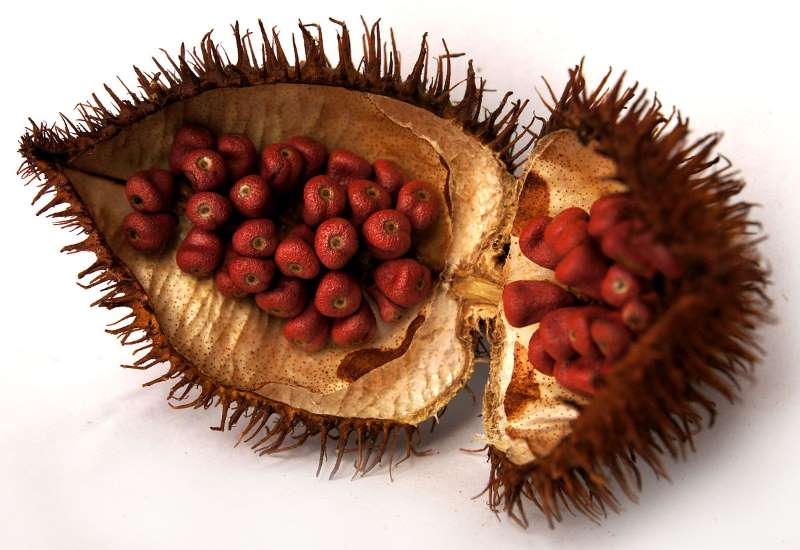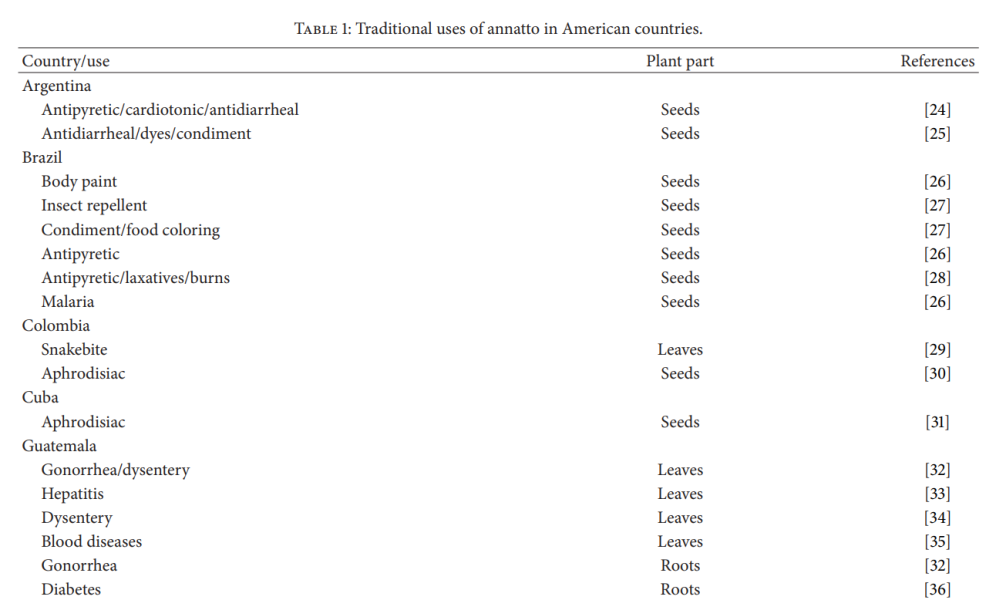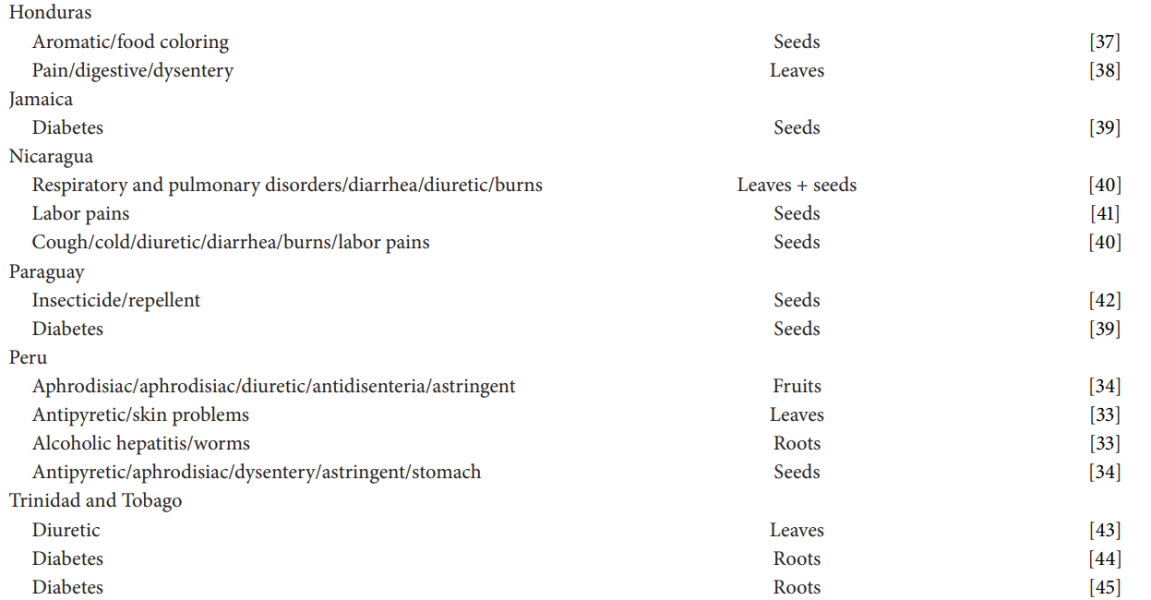
Accepted by the World Health Organization (WHO), annatto (Bixa orellana) is nontoxic and doesn’t affect food’s nutritional value, making it one of the few natural dyes widely approved for consumption. An astonishing 70% of the world’s natural coloring agents come from annatto, further solidifying its dominance in the global market.
Beyond its industrial applications, annatto boasts a variety of proven medicinal properties, making it a valuable resource for pharmaceutical research. From antioxidant and antifungal effects to antimalarial and hypoglycemic activities, annatto demonstrates immense therapeutic promise that extends far beyond its traditional uses.

15 proven medicinal properties of Annatto
A comprehensive study published in 2014 in The Scientific World Journal offers an in-depth review of the traditional uses, chemical constituents, and biological activities of Bixa orellana (annatto). Conducted by researchers from various academic institutions in Brazil, including the Federal University of Paraíba and the Federal University of Rio Grande do Norte, this study consolidates significant findings on the plant’s medicinal properties.
1. Antioxidant Activity
– Annatto extracts, particularly from its seeds, have demonstrated significant antioxidant properties, primarily due to the presence of carotenoids. These antioxidants help in neutralizing free radicals, potentially reducing the risk of chronic diseases like cancer and heart disease.
2. Antifungal Activity
– Annatto has shown promising antifungal activity against various fungal strains such as *Trichophyton mentagrophytes*. This makes it a potential natural remedy for fungal infections, particularly those affecting the skin.
3. Antibacterial Properties
– The extracts from the leaves and seeds of annatto have been tested for their antibacterial properties. Although results vary, there is evidence suggesting that annatto can inhibit the growth of bacteria like *Staphylococcus aureus*.
4. Antimalarial Potential
– Annatto seed extracts have shown moderate activity against *Plasmodium falciparum* and *Plasmodium berghei*, suggesting its potential use as a complementary treatment for malaria.
5. Hypoglycemic Effect
– Traditional uses of annatto in countries like Jamaica include managing blood sugar levels. Scientific studies have supported its hypoglycemic effect, making it a potential natural treatment for diabetes.
6. Anti-inflammatory Properties
– While traditional uses indicate that annatto may have anti-inflammatory effects, particularly for wounds and bruises, further studies are needed to confirm these properties in a clinical setting.
7. Antivenom Activity
– In Colombia, annatto is traditionally used to treat snakebites. Scientific studies have indicated its potential to neutralize the effects of snake venom, providing a natural remedy for such emergencies.
8. Insect Repellent
– Annatto seed extracts have been shown to be effective insect repellents, particularly against mosquitoes. This is supported by its traditional use among indigenous people to protect against insect bites.
9. Cytotoxic Activity Against Cancer Cells
– Some studies have shown that annatto extracts exhibit cytotoxicity against certain cancer cell lines, particularly lung carcinoma cells, highlighting its potential in cancer treatment.
10. Antidiarrheal Properties
– Annatto has been traditionally used in several South American countries to treat diarrhea. This use is supported by its antibacterial properties, which can help combat the bacterial infections that often cause diarrhea.
11. Antiviral Activity
– Annatto has been tested for antiviral properties, particularly against the herpes simplex virus. Although more research is needed, initial findings suggest potential benefits in treating viral infections.
12. Cardiotonic Effects
– Annatto seeds have been used traditionally as a cardiotonic, helping to strengthen the heart and improve its function. Some studies support this use, indicating its potential in cardiovascular health.
13. Wound Healing
– Annatto’s anti-inflammatory and antioxidant properties contribute to its traditional use in wound healing, helping to reduce inflammation and promote faster recovery.
14. Antimutagenic Activity
– Annatto has shown no significant mutagenic activity in scientific studies, indicating its safety as a natural remedy. It may also help protect against genetic mutations, which can lead to various diseases, including cancer.
15. Molluscicidal Activity
– Annatto extracts have been studied for their potential to kill mollusks, which are vectors for parasitic diseases like schistosomiasis. This property makes it a candidate for natural pest control in agricultural settings.
Other traditional uses of annatto


You can access the original paper here: https://onlinelibrary.wiley.com/share/IWB2UHQZYIUKS7QR8DRM?target=10.1155/2014/857292
Source:
Vilar, D. D. A., Vilar, M. S. D. A., Moura, T. F. A. D. L. E., Raffin, F. N., Oliveira, M. R. D., Franco, C. F. D. O., … & Barbosa-Filho, J. M. (2014). Traditional uses, chemical constituents, and biological activities of Bixa orellana L.: a review. The Scientific World Journal, 2014(1), 857292.
Annatto and Genip Documentary Film
If you want to learn more about annatto, traditional uses and legends we kindly invite you to watch the documentary “Annatto and Genip – The colors of the Amazon”
This post is also available in:
![]() Español (Spanish)
Español (Spanish)

